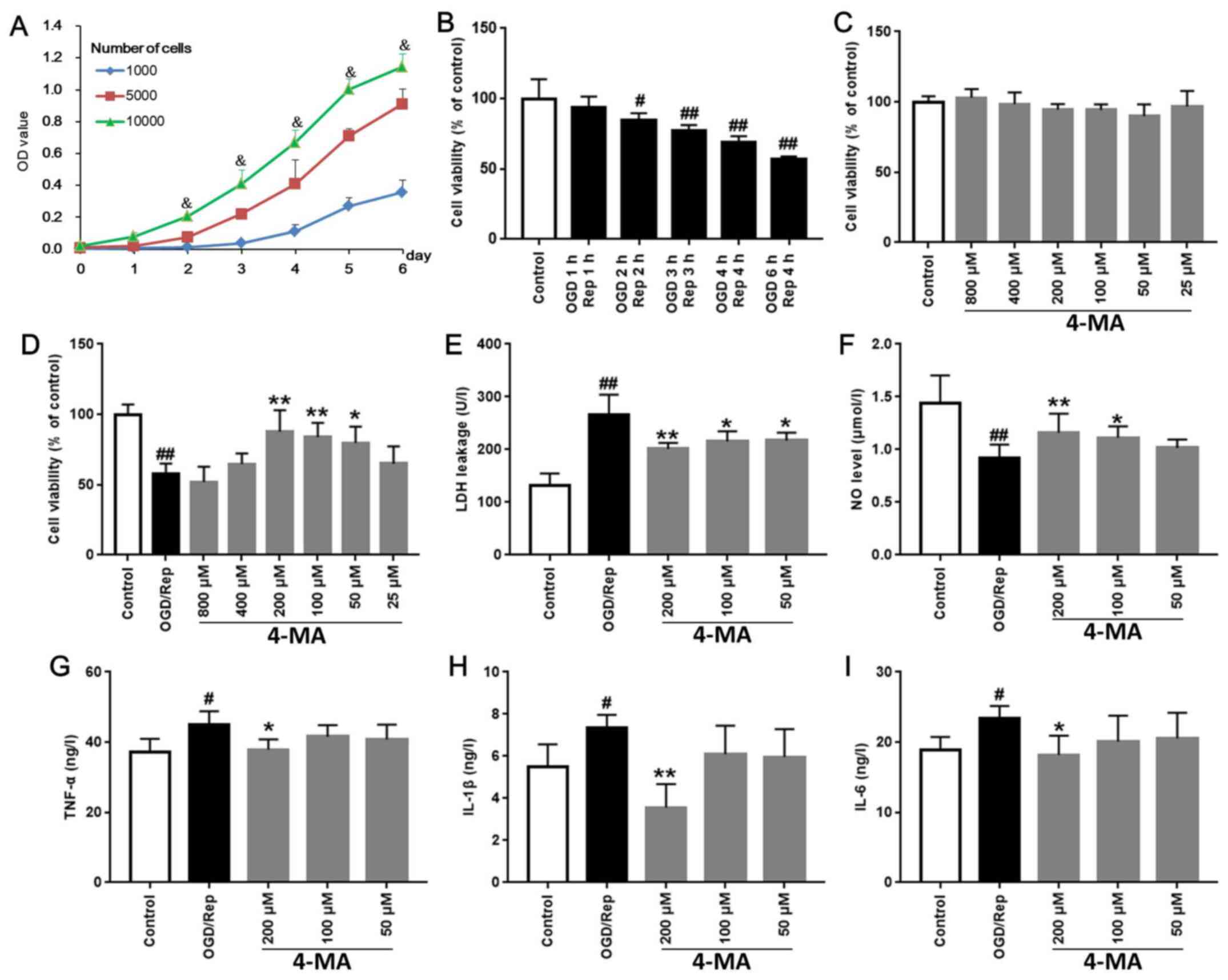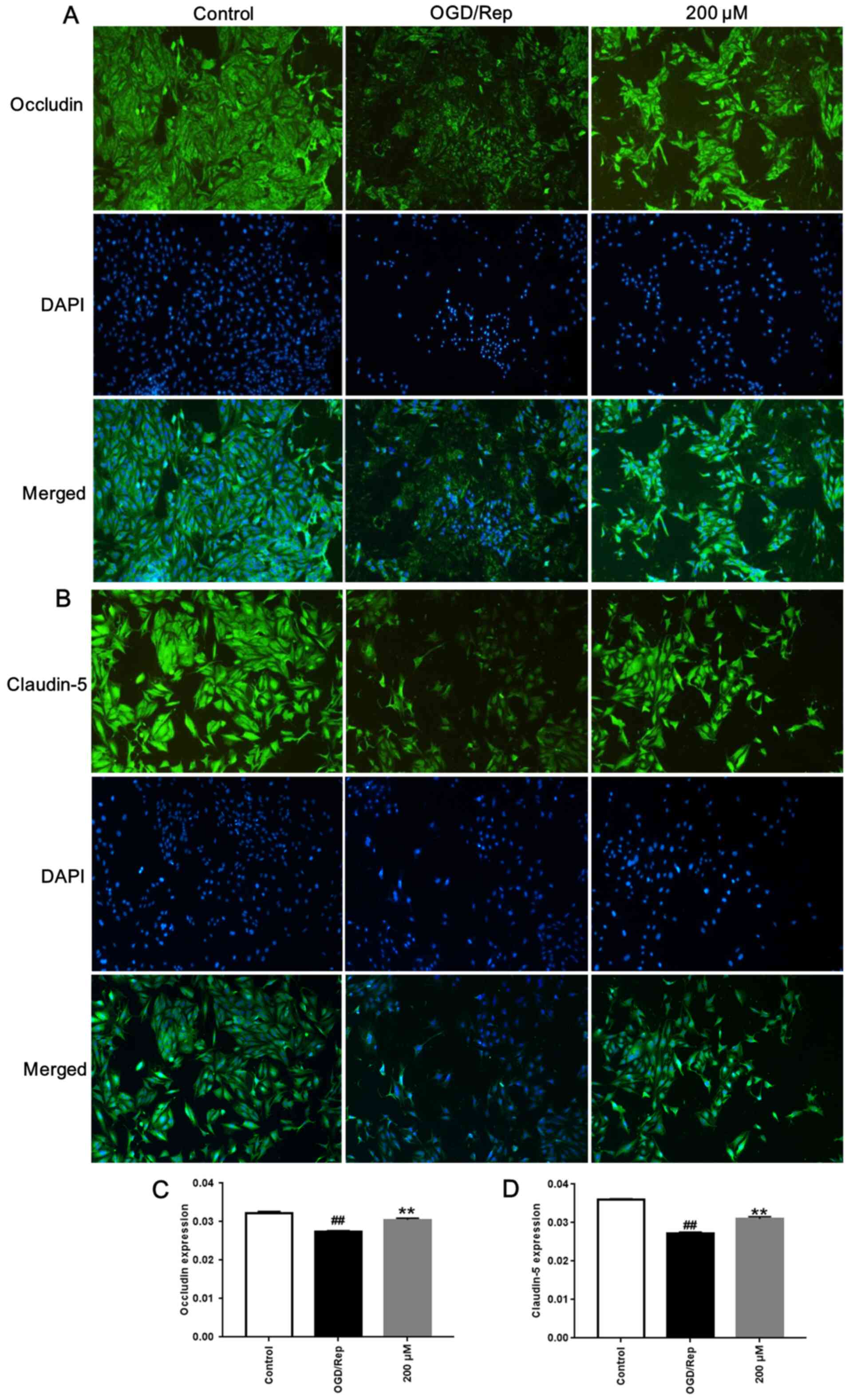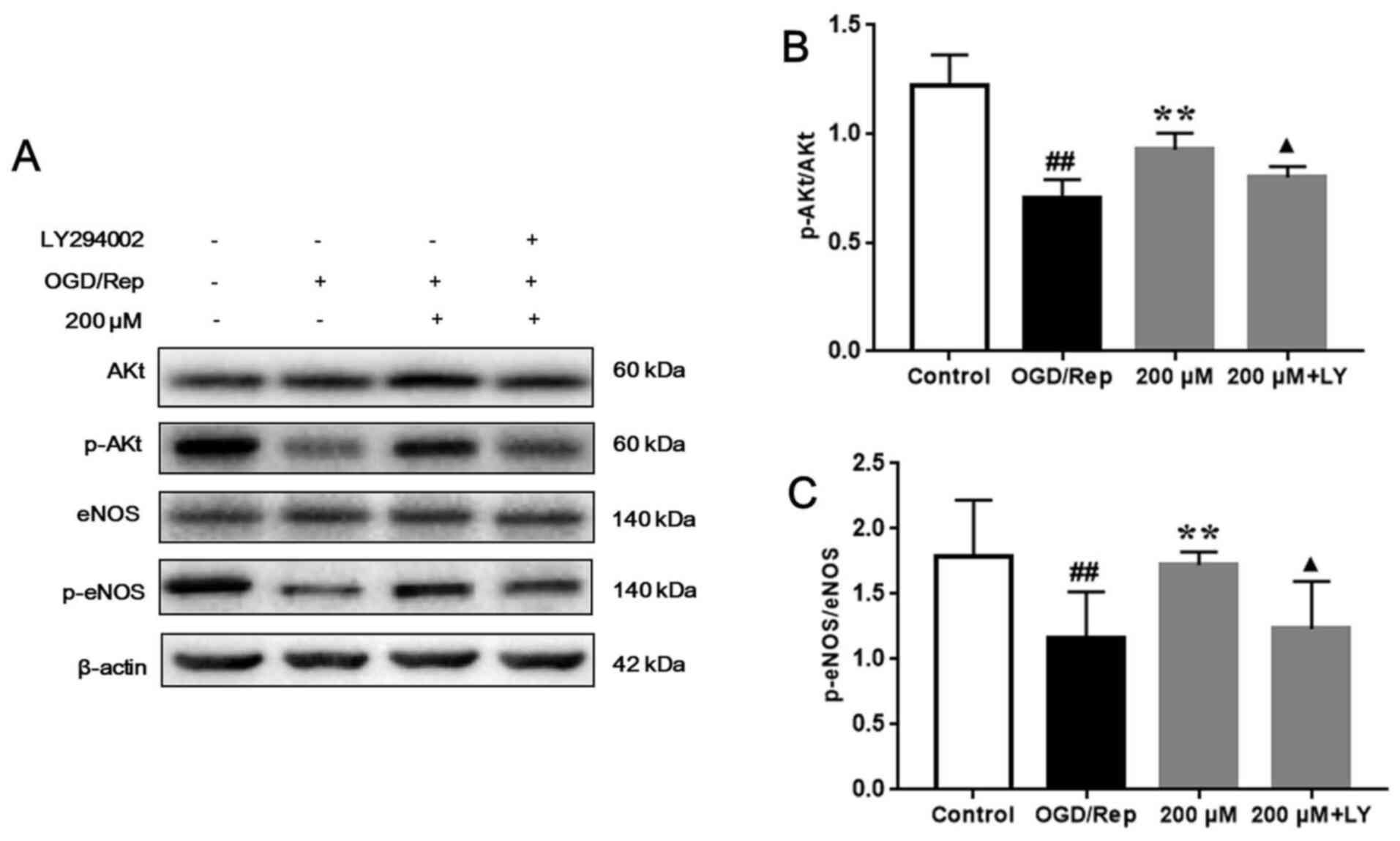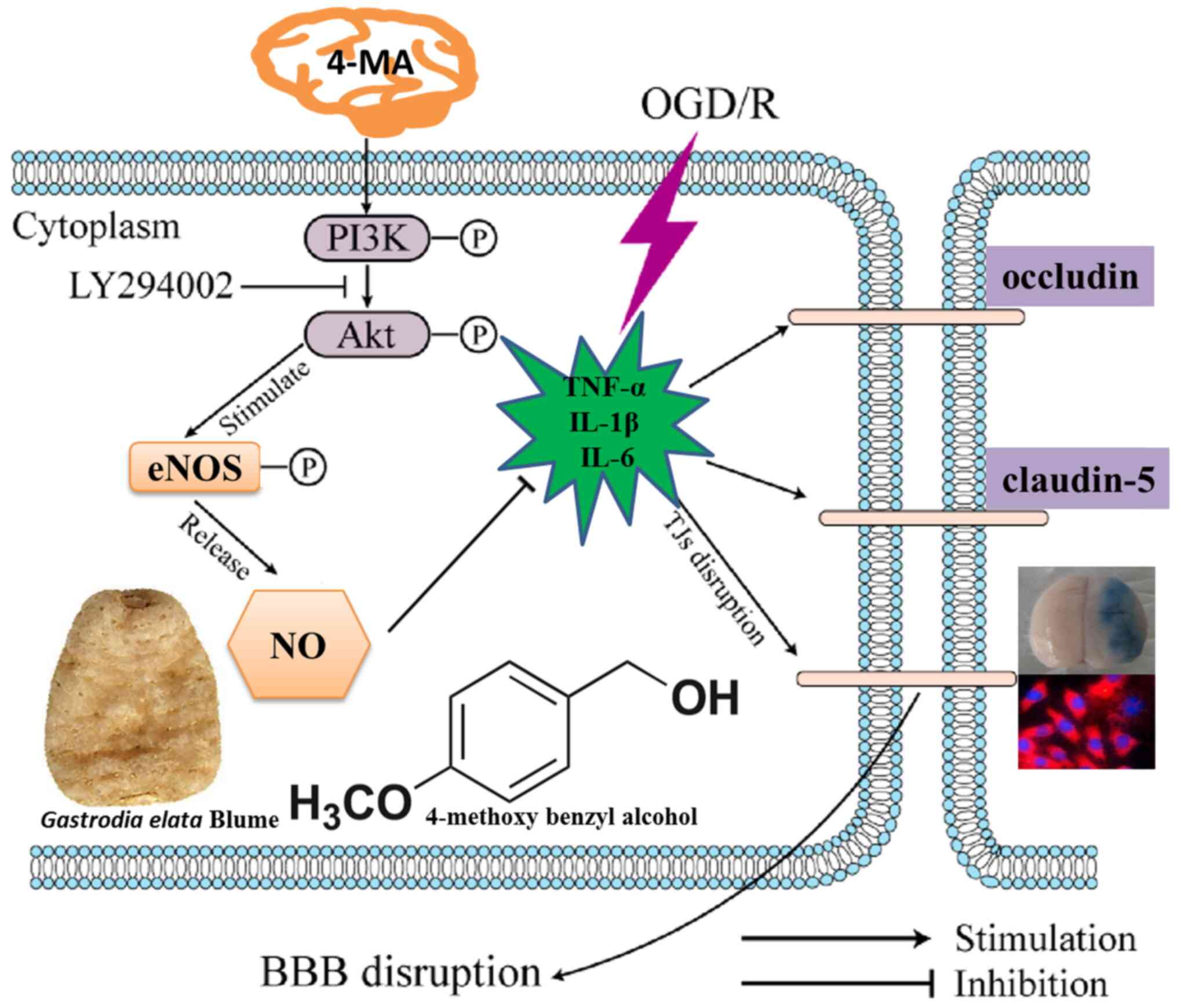|
1
|
Wang F, Cao Y, Ma L, Pei H, Rausch WD and
Li H: Dysfunction of cerebrovascular endothelial cells: Prelude to
vascular dementia. Front Aging Neurosci. 10:376. 2018.PubMed/NCBI View Article : Google Scholar
|
|
2
|
Jiang X, Andjelkovic AV, Zhu L, Yang T,
Bennett MVL, Chen J, Keep RF and Shi Y: Blood-brain barrier
dysfunction and recovery after ischemic stroke. Prog Neurobiol.
163-164:144–171. 2018.PubMed/NCBI View Article : Google Scholar
|
|
3
|
Greene C and Campbell M: Tight junction
modulation of the blood brain barrier: CNS delivery of small
molecules. Tissue Barriers. 4(e1138017)2016.PubMed/NCBI View Article : Google Scholar
|
|
4
|
Abdullahi W, Tripathi D and Ronaldson PT:
Blood-brain barrier dysfunction in ischemic stroke: Targeting tight
junctions and transporters for vascular protection. Am J Physiol
Cell Physiol. 315:C343–C356. 2018.PubMed/NCBI View Article : Google Scholar
|
|
5
|
Zhang H, Park JH, Maharjan S, Park JA,
Choi KS, Park H, Jeong Y, Ahn JH, Kim IH, Lee JC, et al: Sac-1004,
a vascular leakage blocker, reduces cerebral ischemia-reperfusion
injury by suppressing blood-brain barrier disruption and
inflammation. J Neuroinflammation. 14(122)2017.PubMed/NCBI View Article : Google Scholar
|
|
6
|
Zhu S, Tang S and Su F: Dioscin inhibits
ischemic stroke induced inflammation through inhibition of the
TLR4/MyD88/NF-κB signaling pathway in a rat model. Mol Med Rep.
17:660–666. 2018.PubMed/NCBI View Article : Google Scholar
|
|
7
|
Alblihed MA: Astragalin attenuates
oxidative stress and acute inflammatory responses in
carrageenan-induced paw edema in mice. Mol Biol Rep. 47:6611–6620.
2020.PubMed/NCBI View Article : Google Scholar
|
|
8
|
Liu J, Weaver J, Jin X, Zhang Y, Xu J, Liu
KJ, Li W and Liu W: Nitric oxide interacts with caveolin-1 to
facilitate autophagy-lysosome-mediated claudin-5 degradation in
oxygen-glucose deprivatio-treated endothelial cells. Mol Neurobiol.
53:5935–5947. 2016.PubMed/NCBI View Article : Google Scholar
|
|
9
|
Zhang QY, Wang ZJ, Sun DM, Wang Y, Xu P,
Wu WJ, Liu XH and Zhu YZ: Novel therapeutic effects of leonurine on
ischemic stroke: New mechanisms of BBB integrity. Oxid Med Cell
Longev. 2017:7150376. 2017.PubMed/NCBI View Article : Google Scholar
|
|
10
|
Kamat PK, Kalani A, Tyagi SC and Tyagi N:
Hydrogen sulfide epigenetically attenuates homocysteine-induced
mitochondrial toxicity mediated through NMDA receptor in mouse
brain endothelial (bEnd3) cells. J Cell Physiol. 230:378–394.
2015.PubMed/NCBI View Article : Google Scholar
|
|
11
|
Jing Y, Zhang L, Xu Z, Chen H, Ju S, Ding
J, Guo Y and Tian H: Phosphatase actin regulator-1 (PHACTR-1)
knockdown suppresses cell proliferation and migration and promotes
cell apoptosis in the bEnd.3 mouse brain capillary endothelial cell
line. Med Sci Monit. 25:1291–1300. 2019.PubMed/NCBI View Article : Google Scholar
|
|
12
|
Paul D, Baena V, Ge S, Jiang X, Jellison
ER, Kiprono T, Agalliu D and Pachter JS: Appearance of
claudin-5+ leukocytes in the central nervous system
during neuroinflammation: A novel role for endothelial-derived
extracellular vesicles. J Neuroinflammation. 13:292.
2016.PubMed/NCBI View Article : Google Scholar
|
|
13
|
Duan X, Wang W, Liu X, Yan H, Dai R and
Lin Q: Neuroprotective effect of ethyl acetate extract from
gastrodia elata against transient focal cerebral ischemia in rats
induced by middle cerebral artery occlusion. J Tradit Chin Med.
35:671–678. 2015.PubMed/NCBI View Article : Google Scholar
|
|
14
|
He F, Duan X, Dai R, Wang W, Yang C and
Lin Q: Protective effects of ethyl acetate extraction from
gastrodia elata blume on blood-brain barrier in focal cerebral
ischemia reperfusion. Afr J Tradit Complement Altern Med.
13:199–209. 2016.PubMed/NCBI View Article : Google Scholar
|
|
15
|
Duan X, Wang W, Wu S, Yan H, Liu L and Un
Q: Detection of methoxybenzyl alcohol content in brain tissue and
cerebrospinal fluid of rats by HPLC. Med Plant. 5(29)2014.
|
|
16
|
He F, Duan X, Dai R, Li Y and Lin Q:
Protective effect of 4-methoxy benzyl alcohol on the blood-brain
barrier after cerebral ischemia reperfusion injury. J Stroke
Cerebrovasc Dis. 26:1258–1265. 2017.PubMed/NCBI View Article : Google Scholar
|
|
17
|
Xu T, Sun R, Wei G and Kong S: The
protective effect of safinamide in ischemic stroke mice and a brain
endothelial cell line. Neurotox Res. 38:733–740. 2020.PubMed/NCBI View Article : Google Scholar
|
|
18
|
Zhao D, Sun X, Lv S, Sun M, Guo H, Zhai Y,
Wang Z, Dai P, Zheng L, Ye M, et al: Salidroside attenuates
oxidized low density lipoprotein induced endothelial cell injury
via promotion of the AMPK/SIRT1 pathway. Int J Mol Med.
43:2279–2290. 2019.PubMed/NCBI View Article : Google Scholar
|
|
19
|
Zhu W, Qiu W and Lu A: Cryptotanshinone
exhibits therapeutical effects on cerebral stroke through the
PI3K/AKT eNOS signaling pathway. Mol Med Rep. 16:9361–9366.
2017.PubMed/NCBI View Article : Google Scholar
|
|
20
|
Sadeghian N, Shadman J, Moradi A, Ghasem
Golmohammadi M and Panahpour H: Calcitriol protects the Blood-Brain
Barrier integrity against ischemic stroke and reduces vasogenic
brain edema via antioxidant and antiapoptotic actions in rats.
Brain Res Bull. 150:281–289. 2019.PubMed/NCBI View Article : Google Scholar
|
|
21
|
Hu X, De Silva TM, Chen J and Faraci FM:
Cerebral vascular disease and neurovascular injury in ischemic
stroke. Circ Res. 120:449–471. 2017.PubMed/NCBI View Article : Google Scholar
|
|
22
|
Jian Z, Liu R, Zhu X, Smerin D, Zhong Y,
Gu L, Fang W and Xiong X: The involvement and therapy target of
immune cells after ischemic stroke. Front Immunol.
10(2167)2019.PubMed/NCBI View Article : Google Scholar
|
|
23
|
Yang S, Mei S, Jin H, Zhu B, Tian Y, Huo
J, Cui X, Guo A and Zhao Z: Identification of two immortalized cell
lines, ECV304 and bEnd3, for in vitro permeability studies of
blood-brain barrier. PLoS One. 12:e0187017. 2017.PubMed/NCBI View Article : Google Scholar
|
|
24
|
Sweeney MD, Zhao Z, Montagne A, Nelson AR
and Zlokovic BV: Blood-brain barrier: From physiology to disease
and back. Physiol Rev. 99:21–78. 2019.PubMed/NCBI View Article : Google Scholar
|
|
25
|
Cao GS, Chen HL, Zhang YY, Li F, Liu CH,
Xiang X, Qi J, Chai CZ, Kou JP and Yu BY: YiQiFuMai powder
injection ameliorates the oxygen-glucose deprivation-induced brain
microvascular endothelial barrier dysfunction associated with the
NF-κB and ROCK1/MLC signaling pathways. J Ethnopharmacol.
183:18–28. 2016.PubMed/NCBI View Article : Google Scholar
|
|
26
|
Deng F, Wang S, Cai S, Hu Z, Xu R, Wang J,
Feng D and Zhang L: Inhibition of caveolae contributes to propofol
preconditioning-suppressed microvesicles release and cell injury by
hypoxia-reoxygenation. Oxid Med Cell Longev.
2017(3542149)2017.PubMed/NCBI View Article : Google Scholar
|
|
27
|
Chen L, Deng H, Cui H, Fang J, Zuo Z, Deng
J, Li Y, Wang X and Zhao L: Inflammatory responses and
inflammation-associated diseases in organs. Oncotarget.
9:7204–7218. 2017.PubMed/NCBI View Article : Google Scholar
|
|
28
|
Guo T, Wang Y, Guo Y, Wu S, Chen W, Liu N,
Wang Y and Geng D: 1,25-D3 protects from cerebral ischemia by
maintaining BBB permeability via PPAR-γ activation. Front Cell
Neurosci. 12:480. 2018.PubMed/NCBI View Article : Google Scholar
|
|
29
|
Michels M, Ávila P, Pescador B, Vieira A,
Abatti M, Cucker L, Borges H, Goulart AI, Junior CC, Barichello T,
et al: Microglial cells depletion increases inflammation and
modifies microglial phenotypes in an animal model of severe sepsis.
Mol Neurobiol. 56:7296–7304. 2019.PubMed/NCBI View Article : Google Scholar
|
|
30
|
Gu M, Mei XL and Zhao YN: Sepsis and
cerebral dysfunction: BBB damage, neuroinflammation, oxidative
stress, apoptosis and autophagy as key mediators and the potential
therapeutic approaches. Neurotox Res: Sep 2, 2020 (Epub ahead of
print). doi: 10.1007/s12640-020-00270-5.
|
|
31
|
Cao G, Jiang N, Hu Y, Zhang Y, Wang G, Yin
M, Ma X, Zhou K, Qi J, Yu B, et al: Ruscogenin attenuates cerebral
ischemia-induced blood-brain barrier dysfunction by suppressing
TXNIP/NLRP3 inflammasome activation and the MAPK pathway. Int J Mol
Sci. 17(1418)2016.PubMed/NCBI View Article : Google Scholar
|
|
32
|
Puscas I, Bernard-Patrzynski F, Jutras M,
Lécuyer MA, Bourbonnière L, Prat A, Leclair G and Roullin VG: IVIVC
assessment of two mouse brain endothelial cell models for drug
screening. Pharmaceutics. 11(587)2019.PubMed/NCBI View Article : Google Scholar
|
|
33
|
Rempe RG, Hartz AMS, Soldner ELB, Sokola
BS, Alluri SR, Abner EL, Kryscio RJ, Pekcec A, Schlichtiger J and
Bauer B: Matrix metalloproteinase-mediated blood-brain barrier
dysfunction in epilepsy. J Neurosci. 38:4301–4315. 2018.PubMed/NCBI View Article : Google Scholar
|
|
34
|
Lv J, Hu W, Yang Z, Li T, Jiang S, Ma Z,
Chen F and Yang Y: Focusing on claudin-5: A promising candidate in
the regulation of BBB to treat ischemic stroke. Prog Neurobiol.
161:79–96. 2018.PubMed/NCBI View Article : Google Scholar
|
|
35
|
Tian J, Zhang X, Wu H, Liu C, Li Z, Hu X,
Su S, Wang LF and Qu L: Blocking the PI3K/AKT pathway enhances
mammalian reovirus replication by repressing IFN-stimulated genes.
Front Microbiol. 6:886. 2015.PubMed/NCBI View Article : Google Scholar
|
|
36
|
Wang SW, Deng LX, Chen HY, Su ZQ, Ye SL
and Xu WY: MiR-124 affects the apoptosis of brain vascular
endothelial cells and ROS production through regulating PI3K/AKT
signaling pathway. Eur Rev Med Pharmacol Sci. 22:498–505.
2018.PubMed/NCBI View Article : Google Scholar
|
|
37
|
Lv X, Xu T, Wu Q, Zhou Y, Huang G, Xu Y
and Zhong G: 6-Gingerol activates PI3K/Akt and inhibits apoptosis
to attenuate myocardial ischemia/reperfusion injury. Evid Based
Complement Alternat Med. 2018(9024034)2018.PubMed/NCBI View Article : Google Scholar
|
|
38
|
Song J, Kang SM, Lee WT, Park KA, Lee KM
and Lee JE: The beneficial effect of melatonin in brain endothelial
cells against oxygen-glucose deprivation followed by
reperfusion-induced injury. Oxid Med Cell Longev.
2014(639531)2014.PubMed/NCBI View Article : Google Scholar
|
|
39
|
Chi OZ, Mellender SJ, Kiss GK, Liu X and
Weiss HR: Blood-brain barrier disruption was less under isoflurane
than pentobarbital anesthesia via a PI3K/Akt pathway in early
cerebral ischemia. Brain Res Bull. 131:1–6. 2017.PubMed/NCBI View Article : Google Scholar
|
|
40
|
Hu S, Wu Y, Zhao B, Hu H, Zhu B, Sun Z, Li
P and Du S: Panax notoginseng saponins protect cerebral
microvascular endothelial cells against oxygen-glucose
deprivation/reperfusion-induced barrier dysfunction via activation
of PI3K/Akt/Nrf2 antioxidant signaling pathway. Molecules.
23(2781)2018.PubMed/NCBI View Article : Google Scholar
|


















